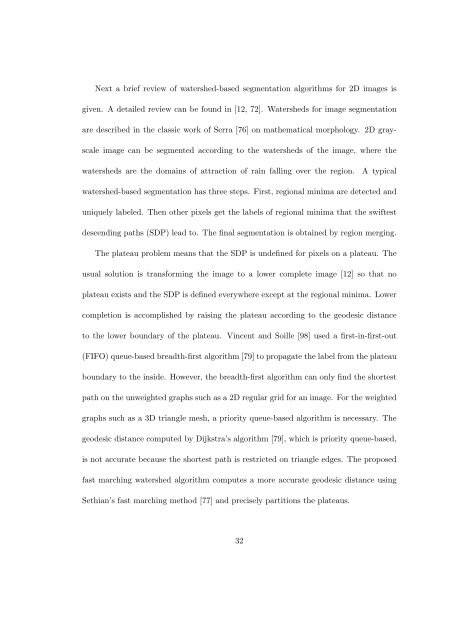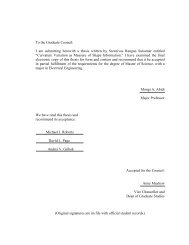To the Graduate Council: I am submitting herewith a dissertation ...
To the Graduate Council: I am submitting herewith a dissertation ...
To the Graduate Council: I am submitting herewith a dissertation ...
You also want an ePaper? Increase the reach of your titles
YUMPU automatically turns print PDFs into web optimized ePapers that Google loves.
Next a brief review of watershed-based segmentation algorithms for 2D images isgiven. A detailed review can be found in [12, 72]. Watersheds for image segmentationare described in <strong>the</strong> classic work of Serra [76] on ma<strong>the</strong>matical morphology. 2D grayscaleimage can be segmented according to <strong>the</strong> watersheds of <strong>the</strong> image, where <strong>the</strong>watersheds are <strong>the</strong> domains of attraction of rain falling over <strong>the</strong> region.A typicalwatershed-based segmentation has three steps. First, regional minima are detected anduniquely labeled. Then o<strong>the</strong>r pixels get <strong>the</strong> labels of regional minima that <strong>the</strong> swiftestdescending paths (SDP) lead to. The final segmentation is obtained by region merging.The plateau problem means that <strong>the</strong> SDP is undefined for pixels on a plateau. Theusual solution is transforming <strong>the</strong> image to a lower complete image [12] so that noplateau exists and <strong>the</strong> SDP is defined everywhere except at <strong>the</strong> regional minima. Lowercompletion is accomplished by raising <strong>the</strong> plateau according to <strong>the</strong> geodesic distanceto <strong>the</strong> lower boundary of <strong>the</strong> plateau. Vincent and Soille [98] used a first-in-first-out(FIFO) queue-based breadth-first algorithm [79] to propagate <strong>the</strong> label from <strong>the</strong> plateauboundary to <strong>the</strong> inside. However, <strong>the</strong> breadth-first algorithm can only find <strong>the</strong> shortestpath on <strong>the</strong> unweighted graphs such as a 2D regular grid for an image. For <strong>the</strong> weightedgraphs such as a 3D triangle mesh, a priority queue-based algorithm is necessary. Thegeodesic distance computed by Dijkstra’s algorithm [79], which is priority queue-based,is not accurate because <strong>the</strong> shortest path is restricted on triangle edges. The proposedfast marching watershed algorithm computes a more accurate geodesic distance usingSethian’s fast marching method [77] and precisely partitions <strong>the</strong> plateaus.32
















